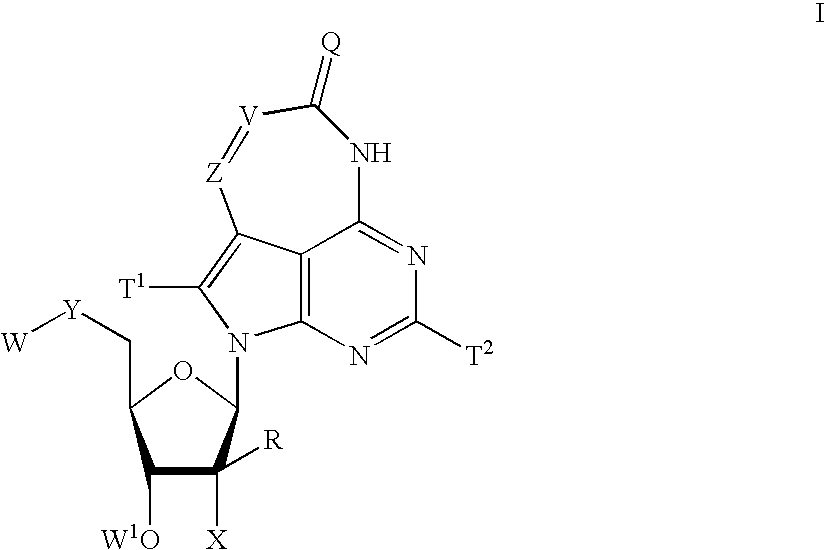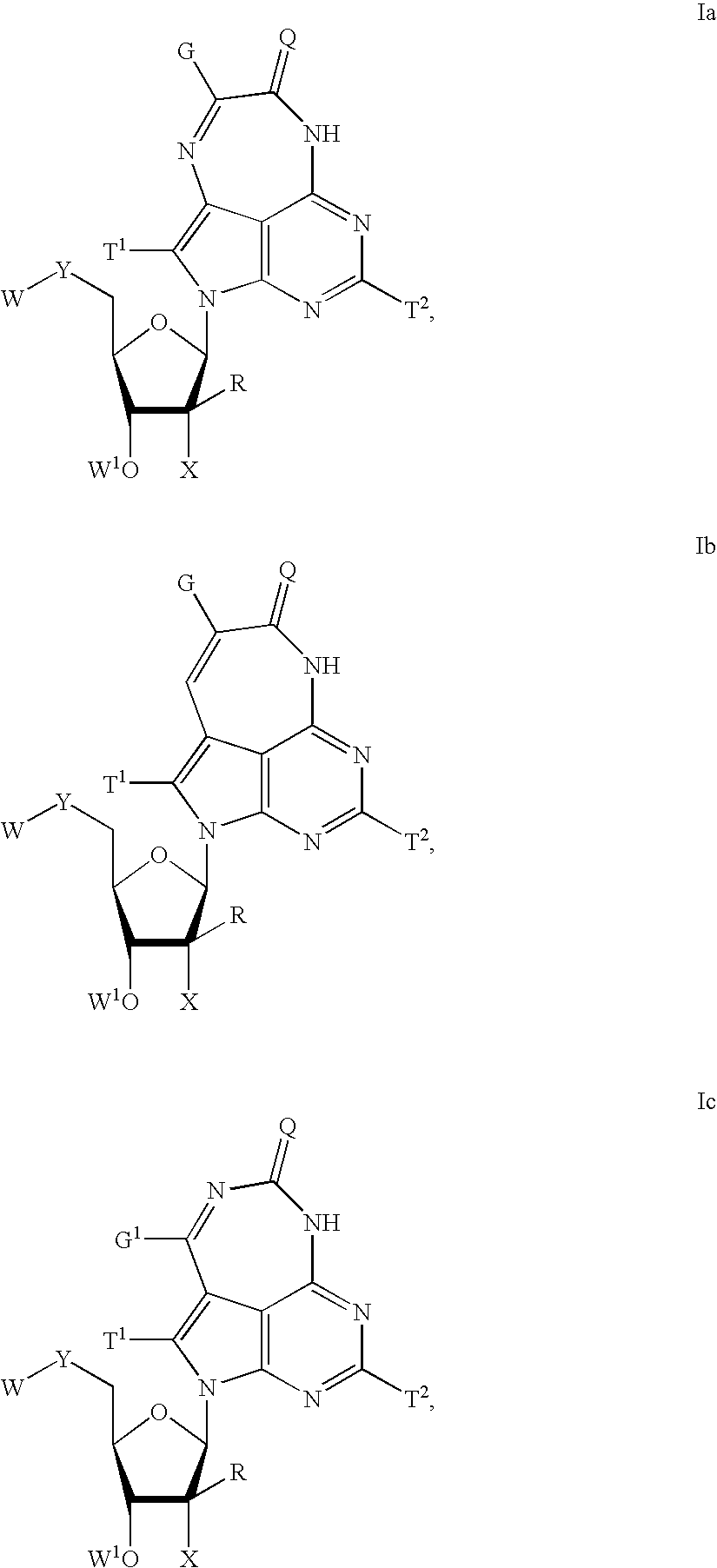Tricyclic-nucleoside compounds for treating viral infections
a technology of nucleosides and compounds, applied in the field of pharmaceutical chemistry, can solve the problems of liver failure, no compound described above has progressed beyond clinical trials, and the number of patients still has significant side effects
- Summary
- Abstract
- Description
- Claims
- Application Information
AI Technical Summary
Benefits of technology
Problems solved by technology
Method used
Image
Examples
example 6
Preparation of 9-amino-2-(β-D-ribofuranosyl)-2,6-dihydro-7H-2,3,5,6-tetraazabenzo[cd]azulen-7-one (Compound 306)
Step 1. 2,3-O-isopropylidene-D-ribofuranose
[0466]Into a suspension of D-ribose (50 g, 0.33 mol) in acetone (1500 mL) was added sulfuric acid (1 mL) dropwise. Reaction mixture was stirred overnight at room temperature and then neutralized with sat. aq. NaHCO3. Solution was decanted and concentrated. Oily residue was dissolved in EtOAc (1000 mL) and washed with water (300 mL). Aqueous layer was re-extracted with EtOAc (2×500 mL). Combined extracts were dried over Na2SO4 and concentrated to yield the target compound (42.3 g, 67.3%) as oil which was used as such for the next step.
Step 2. 5-O-tert-Butyldimethylsily-2,3-O-isopropylidene-D-ribofuranose
[0467]2,3-O-isopropylidene-D-ribofuranose, obtained as described above (21.7 g, 0.114 mol) was dissolved in anhydrous CH2Cl2 (600 mL) and imidazole (15.53 g, 0.228 mol) and TBDMSCl (18.90 g, 0.125 mol) were added under argon. After ...
example 7
Preparation of 2-(2′-methyl-β-D-ribofuranosyl)-9-methylamino-2,6-dihydro-2,3,5,6-tetraaza-benzo[cd]azulen-7-one (Compound 307)
[0484]The product from Example 1, Step 5 (225 mg, 0.598 mmol) in methylamine (9 mL, 1 M in THF) was sealed in an autoclave bomb and heated to 80° C. for 1 hour. The reaction mixture was concentrated and the residue was taken up in 11.6 mL of 0.5 M NaOEt and heated to 80° C. for 1 hour. The reaction mixture was concentrated and purified on Phenomenex-C18 reverse phase HPLC with a 0-40% B gradient over 20 min at 10 mL / min (Buffer A=H2O, Buffer B=acetonitrile) to afford 110 mg of the title compound;
[0485]1H NMR (DMSO-d6): δ 0.76 (s, 3H), 2.82 (d, 3H, J=4.2)3.72-3.98 (m, 4H), 4.81 (d, 1H), 4.88 (t, 1H) 5.24 (d, 1H, J=8.1), 5.25(s, 1H), 6.20 (s, 1H), 7.08 (d, 1H, J=4.8), 7.80 (s, 1H), 8.32 (s, 1H), 10.16 (s, 1H);
[0486]MS (M+1): 362.15.
example 8
Preparation of 2-(2′-methyl-β-D-ribofuranosyl)-2,6,7,9-tetrahydro-2,3,5,6,9-pentaaza-benzo[cd]azulen-8-one (Compound 308)
Step 1. 4-Chloro-7-(2′-methyl-β-D-ribofuranosyl)-7H-pyrrolo[2,3-d]pyrimidine
[0487]The target compound was synthesized according to the procedure in U.S. Pat. No. 6,777,395.
Step 2. 4-Chloro-7-(2′-methyl-2′,3′,5′-tris-O-acetyl-β-D-ribofuranosyl)-7H-pyrrolo[2,3-d]pyrimidine
[0488]To a solution of the product from Step 1 (1.0 g, 3.34 mmol) in glacial acetic acid (14 mL) was added acetyl chloride (4 mL) and the mixture was stirred at room temperature overnight. The reaction was then concentrated in vacuo, co-evaporated with toluene, and purified by Isco CombiFlash purification system with a 40 g silica gel column and 0-35% MeOH gradient in DCM over 30 minutes to afford 1.4 g (99%).
[0489]MS (M+1): 471.0
Step 3. 4-Chloro-7-(2′-methyl-2′,3′,5′-tris-O-acetyl-β-D-ribofuranosyl)-5-nitro-7H-pyrrolo[2,3-d]pyrimidine
[0490]A solution of the product from Step 2 (700 mg, 1.64 mmol) ...
PUM
| Property | Measurement | Unit |
|---|---|---|
| Volume | aaaaa | aaaaa |
| Volume | aaaaa | aaaaa |
| Mass | aaaaa | aaaaa |
Abstract
Description
Claims
Application Information
 Login to View More
Login to View More - R&D
- Intellectual Property
- Life Sciences
- Materials
- Tech Scout
- Unparalleled Data Quality
- Higher Quality Content
- 60% Fewer Hallucinations
Browse by: Latest US Patents, China's latest patents, Technical Efficacy Thesaurus, Application Domain, Technology Topic, Popular Technical Reports.
© 2025 PatSnap. All rights reserved.Legal|Privacy policy|Modern Slavery Act Transparency Statement|Sitemap|About US| Contact US: help@patsnap.com



